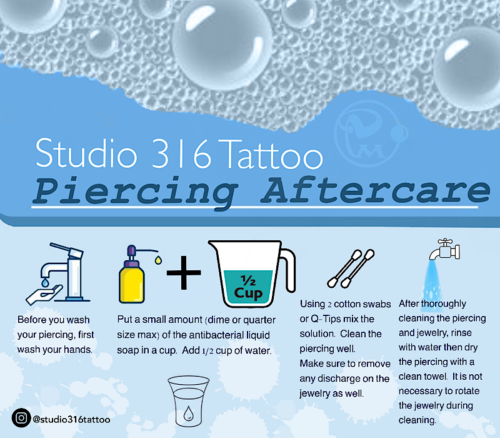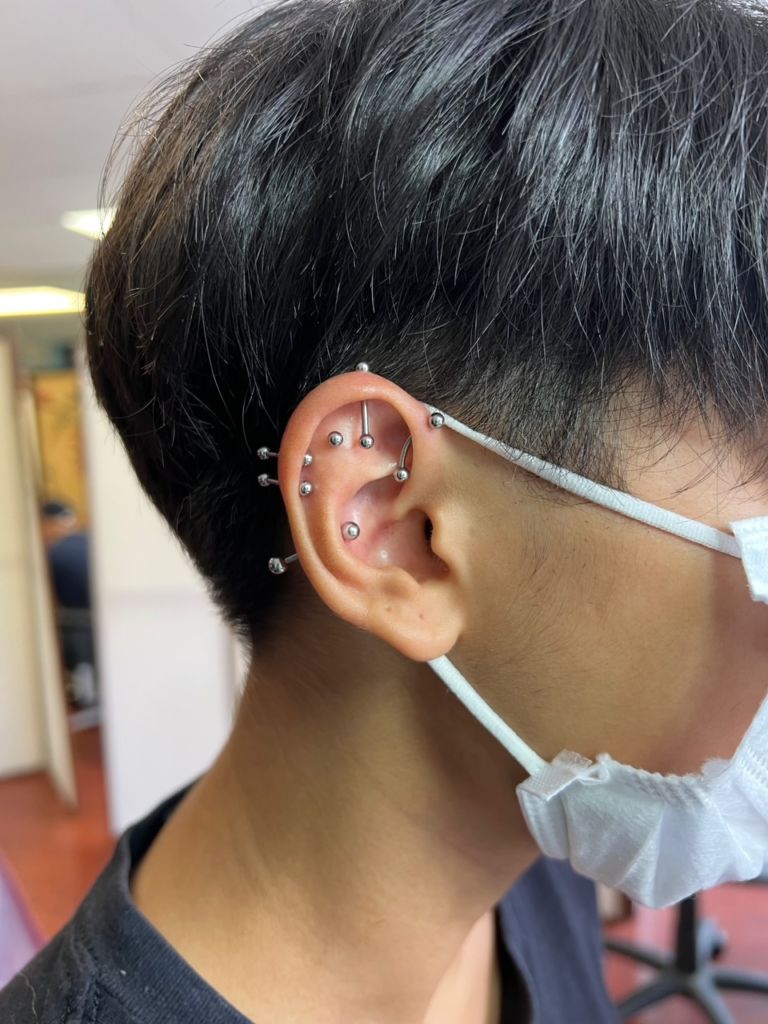FAQs
You can be assured that your piercing has been performed appropriately, and that the very highest standards of technique and sterilization have been used. All of our suggestions are made based on our own experience, research, and also on that of other professionals in the piercing industry.
Since you have already trusted “Studio 316 tattoo body art” to perform your piercing, please follow through and follow our judgment regarding care of your new adornment. What follows is a general outline of information regarding a new piercing. For more detailed information, please do not hesitate to visit us.
Non-Oral Piercing FAQ
Before you wash your piercing, first wash your hands. Never touch your piercing with dirty hands. This is the easiest way to get an infection.Do not apply the soap directly to the piercing. Put a small amount(dime or quarter size max) of the antibacterial liquid soap in a cup. Add 1/2 cup of water , use 2 cosmetic cotton swab (cosmetic Q-Tips) or non-woven gauze to mix the solution, clean piercing well. Make sure to remove any discharge on the jewelry. After thoroughly cleaning the piercing and jewelry, rinse with water then dry the piercing with a clean towel or sterile non-woven gauze (This is often easiest to do at the end of your shower). Avoid regular cotton swabs as they leave behind tiny fibres that cause irritation.
Dry the area well as moisture can lead to bacteria. It is not necessary to rotate the jewelry during cleaning. Clean it Twice a day till it heals.
See image for reference

Clean your piercing until it is fully healed, which can take several months depending on the placement and your body.
No, you should not remove your “initial piercing jewelry”. With new piercings, wherever they’re located on the body, they should never be removed before the time frame given by your piercer. You do not need to twist or rotate the jewelry. The general idea is to always keep the piercing site clean and free from bacteria.
A good example Dial Clean+ Gentle Hypoallergenic Antibacterial Liquid Hand Soap, Fragrance free.

A sea salt solution mixture can be a viable addition to your aftercare , not a replacement for the antibacterial liquid soap. Dissolve 1∕8 to 1⁄4 teaspoon (.75 to 1.42 grams) of non-iodized (iodine free), fine grain sea salt into one cup (8 oz. / 250ml) of warm distilled or bottled water. A stronger mixture is not better; salt solution that is too strong can irritate the piercing. Please, DO NOT mix your own saline. Mixing your own sea salt solution will commonly result in the product being far too salty and strong, this can over dry the piercing, interfere with healing and could lead to an infection. It takes time to make, it is impossible to store and remain sterile and will likely introduce bacteria and debris into your piercing.
Initially: a little bleeding, tenderness, site swelling, redness around the site of the piercing, or some bruising.
During healing: some discoloration, itching, secretion of a whitish-yellow fluid (not pus) that will form some crust on the jewelry.
The piercing will naturally drain healthy fluids in the first days and maybe for longer.
If left to dry, these will form crusts, which will be rough, sometimes pointy and can harbour bacteria. It is important to soak those crusts with antibacterial liquid soap + 1/2 cup water, soften them, gently remove them and afterwards DRY the area.
Moisture can lead to bacteria. Dry the area well with new cotton buds, sterile non-woven gauze or using the cold setting on a hairdryer.
Failure to keep the piercing exit wounds clear, will cause smelly crusts to accumulate which will harbour bacteria and grow over time. The healthy fluids will not have where to drain to and will form fluid bumps on the exit wounds, which if left untreated for a long time could persist even after a piercing is retired.
Once healed: the jewelry may not move freely in the piercing; do not force it. If you fail to include cleaning your piercing as part of your daily hygiene routine, normal but smelly bodily secretions may build up.
A piercing may seem healed before the healing process is complete. This is because tissue heals from the outside in, and although it feels fine, the interior remains as open wound. Be patient, and keep cleaning throughout the entire healing period.
Even healed piercings can shrink or close in minutes after having been there for years!. This varies from person to person; if you like your piercing, keep jewelry in don’t leave it empty.
No, we don’t recommend them. Keep in mind these products are for skin care and not for cleaning a new piercing. Example do not use Kiehl’s Ultra Facial Cleanser, etc
Do not sleep on your Cartilage Piercing. Sleeping directly on a healing cartilage piercing can cause irritation, even causing shifts in the piercing’s angle. Placing a travel pillow, on top of your pillow, and then placing your ear in the opening can be helpful to avoid this.
Avoid using any aftercare or cleaning product not recommended by us.
Avoid over-cleaning. This will delay your healing and irritate your piercing.
Avoid touching or rotating your piercing.
Avoid moving the jewellery in an unhealed piercing, or picking away dried discharge with your fingers
Avoid undue trauma such as friction, excessive motion of the area, playing with the jewelery, and vigorous cleaning. These activities can cause the formation of unsightly and uncomfortable scar tissue, migration, prolonged healing, and other complications.
The new piercing is a deep open wound with a foreign object in it.
Please treat it as such, because touching it with dirty hands will cause swelling and possibly an infection.
The piercing will naturally drain healthy fluids in the first days and maybe for longer.
If left to dry, these will form crusts, which will be rough, sometimes pointy and can harbour bacteria.
It is important to soak those crusts with water, soften them, gently remove them and afterwards dry the area.
Failure to keep the piercing exit wounds clear, will cause smelly crusts to accumulate which will harbour bacteria and grow over time.
The healthy fluids will not have where to drain to and will form fluid bumps on the exit wounds, which if left untreated for a long time could persist even after a piercing is removed.
Avoid cleaning with alcohol, hydrogen peroxide, iodine, or any harsh products, as these can damage cells.
Avoid ointments like Bacitracin, Neosporin Triple Antibiotic Ointment, double antibiotic ointments like Polysporin as they prevent necessary air circulation and it can cause the skin to become red, scaly, and itchy. The more ointment you use, the worse the skin reaction gets.
Avoid Bactine and related products, pierced ear care solutions, advanced healing + scar defense hydrogels and other products containing Benzalkonium Chloride (BZK).example simply saline wound care 3-in-1, simple saline wound wash, Studex after piercing solutiom, etc. These can be irritating and are not intended for long-term wound care.
Avoid submerging the piercing in unhygienic bodies of water such as lakes, swimming in chlorinated pool, hot tubs, etc. Or, protect your piercing using a waterproof wound sealant bandage. These are available at most drugstores and work best for nipple, navel, and surface piercing placements.
Avoid all beauty and personal care products on or around the piercing including cosmetics, lotions, and sprays, etc.
Avoid Hibiclens (Chlorhexidine Gluconate solution 4.0%) Antiseptic/Antimicrobial Skin Cleanser.
If your metal jewelry needs to be temporarily removed for a medical procedure, the use of retainers is a must.
Do not pull or pick the dried matter because it is attached to the healing tissue
Leave jewelry in until fully healed. Even healed piercings that you have had for years can shrink or close in minutes!. If removed, reinsertion can be difficult or impossible.
You no longer want the piercing, simply remove the jewelry (or visit us to remove it) and continue cleaning the piercing until the hole closes
Refrain from putting body creams, makeup, moisturizers, and perfumes directly on the piercing.
Oral Piercing Aftercare
Oral aftercare is not just for tongue piercings, but also for any lip piercings, such as a philtrum or monroe. This aftercare should be followed for the first 30 days after receiving your new oral piercing.
We suggest maintaining good oral hygiene when healing an oral piercing. We do not suggest mouthwash as a form of aftercare. If you like using mouthwash, make sure you have a non-alcohol based mouthwash and do not overuse the product. We suggest for the first 30 day prior to your downsize that you rinse your mouth with Purified/distilled water. Rinse approximately 15-20 seconds. This will take place after eating, smoking, oral contact, or drinking anything other than water.
Oral piercings swell quite a bit, and can last up to 3-7 days. In some cases, swelling may reoccur up to 30 days after being pierced, so it is important to keep the original jewelry in during this crucial healing time. After 30 days, we suggest returning for a downsize on your jewelry.
Anti-inflammatories: OTC Ibuprofen or Naproxen Sodium (taken according to package directions) can help with swelling and pain associated with oral piercings.
Ice: crushed ice is easier to deal with, especially for tongue piercings.
Soft, cold foods are best for the first 3 days. Avoid hot or spicy foods.
Tooth enamel loss and gum recession are potential complications with oral piercings. Pay a close attention to your gum and don’t and paying with the jewelry.
Call your Piercer
718.803.3977


